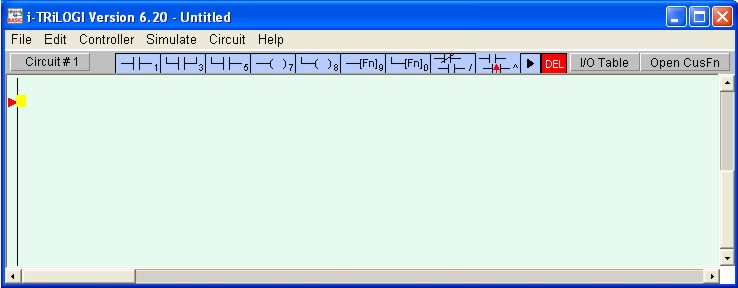i-TRiLOGI comes with a smart editor which allows you to insert or delete a single element within a circuit easily. The editor interprets your circuit immediately upon entry and prevents you from creating illegal circuit connections. The functions of various keys in the circuit editing mode are detailed below. You know that you are in the circuit editing mode when a row of ladder logic icons appears along the upper status line next to the circuit number and a yellow color highlight bar appears and you can move it to select an element in the ladder circuit, as shown below:
Mouse Actions
Left Click - When you click on an element using a the left mouse button, the element is selected and highlighted by the yellow color highlight bar.
Right Click - When you click on an element using the right mouse button, you are allowed to directly edit the label name of the element. This can be a convenient feature if you need to change one or two characters in the name only. However, if the element is a custom function [dCusFn], or [CusFn], then the custom function editor will be opened for you to edit the function directly.
Insert Ladder Element - You create the ladder circuit element simply by moving the mouse pointer to the icon and pressing either the left or the right mouse button to insert a ladder logic element to the currently highted element. The following is a description of the functions of each icon. A yellow color highlight bar will appear which you can move to select an element in the ladder circuit.
|
<1> - Left click to insert a normally-open series contact. <2> - Right click to insert a normally-closed series contact. |
| <3> - Left click to insert a N.O. parallel contact to highlighted
element <4> - Right click to insert a N.C. parallel contact to highlighted element |
|
| <5> - Left click to insert a N.O. parallel contact to enclose one or
more elements. <6> - Right click to insert a N.C. parallel contact to enclose one or more elements. |
|
| <7> - Insert a normal coil which may be an output, relay, timer or counter. | |
| <8> - Insert a parallel output coil (not an entire branch) to the current coil. | |
| <9> - Insert a special function coil which includes execution of CusFn | |
| <0> - Insert a parallel special function coil to the current coil. | |
| </> - Invert the element from N.O. to N.C. or from N.C. to N.O. | |
| <^> - Convert the element to a rising-edge triggered contact (one shot) | |
| Click to move the highlight bar to the right (same effect as pressing the right arrow key). This can be used to move the cursor to a junction which cannot be selected by mouse click. | |
| Double-click to delete a highlighted element. This acts as a safety against mistake. |
